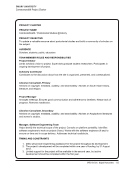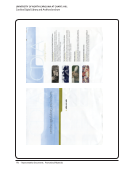60 · Survey Results: Survey Questions and Responses
Our approach is not to differentiate digital humanities projects vs sciences. We’re trying to start with sciences since we
may get grants. Then, it will trickle down to humanities. Our university administration is supportive of these efforts,
specially the new cyberinfrastructure Center.
Our Dean is very supportive of the direction we are taking to improve our library’s digital humanities offerings. We
are also trying to think even more broadly, beyond the humanities, although we do feel that the humanities are
an important target. The Wired Humanities Project was founded in the late 1990s when “humanities computing”
was getting off the ground. Fortunately, we had the support of a few administrators who understood this new
“interdiscipline” and the potential for winning external funding for faculty projects. Our unit is now in its third home on
campus, having been born as a spinoff of another research center (on gender), then being given a temporary home in
a language center, and now finally having a home (less than a year) in the library, where the Dean is very aware of the
growing research-library role in providing digital humanities services. Our success at winning federal grants has helped
keep us alive through drastic budget cuts and other obstacles. Fortunately, the field (now called “digital humanities”)
has caught on with lending agencies. The availability of grants in DH has caught the attention not only of administrators
but of more and more faculty and graduate students, too, making our job much easier. In fact, we need to consolidate
and expand to meet the growing interest/demand.
Our Digital Humanities Center is still very new and establishing a strategic plan, mission, and vision. Our faculty
members are exploring digital scholarship in a variety of ways and have involved the library staff as collaborators in
every project so we envision playing an important role in Humanities Scholarship.
Our library is still very much developing its digital humanities services in terms of defining what our services will be,
implementing marketing and outreach, and training staff. But with two recent hires for a visual media digitization
coordinator and a digital humanities specialist for Library IT, we are quickly building a team of specialized personnel who
are dedicated to assisting researchers with digital humanities projects.
Support of DH projects at IU has developed organically over several years, but until very recently there hasn’t been a
sustained effort to communicate and work together. In addition to the Digital Library Program (http://www.dlib.indiana.
edu/) and IDAH (http://www.indiana.edu/~idah/), the university’s institutional repository, IUScholarWorks (http://
scholarworks.iu.edu/) and the University IT Services (http://uits.iu.edu/), particularly the Advanced Visualization Lab
(http://www.avl.iu.edu/) also provide services of various sorts to humanities faculty.
The CBSR works with individuals and organizations in California, nationally, and internationally to identify potential
partners and projects and manage projects.
The demand started out small and could be managed on an ad hoc basis. As demand has increased we have scrambled
to meet demands just as the library itself has demanded more digital know-how. We are preparing to launch a new
research center which should allow us to work more efficiently.
The focus of our Digital Library Program includes the humanities as major partners, but is not limited to their needs
solely. Digital Humanities support also available from various IT service points, and from the campus Humanities Center.
The institution supports digital scholarship in a decentralized manner. Library staff serve as members of the initiative.
The library staff in Digital Collections work with the Digital Humanities staff on grant proposals and the Digital
Collections Librarian is on the board of the Digital Humanities Center.
This is new area that is not yet a distinct service within umbrella of digital initiatives. We have a few projects that are
digital humanities, more in the queue, but are still staffing up to handle the projects in hand. More structure, policy
development, and procedural solutions will occur in next 12 to 18 months.
Our approach is not to differentiate digital humanities projects vs sciences. We’re trying to start with sciences since we
may get grants. Then, it will trickle down to humanities. Our university administration is supportive of these efforts,
specially the new cyberinfrastructure Center.
Our Dean is very supportive of the direction we are taking to improve our library’s digital humanities offerings. We
are also trying to think even more broadly, beyond the humanities, although we do feel that the humanities are
an important target. The Wired Humanities Project was founded in the late 1990s when “humanities computing”
was getting off the ground. Fortunately, we had the support of a few administrators who understood this new
“interdiscipline” and the potential for winning external funding for faculty projects. Our unit is now in its third home on
campus, having been born as a spinoff of another research center (on gender), then being given a temporary home in
a language center, and now finally having a home (less than a year) in the library, where the Dean is very aware of the
growing research-library role in providing digital humanities services. Our success at winning federal grants has helped
keep us alive through drastic budget cuts and other obstacles. Fortunately, the field (now called “digital humanities”)
has caught on with lending agencies. The availability of grants in DH has caught the attention not only of administrators
but of more and more faculty and graduate students, too, making our job much easier. In fact, we need to consolidate
and expand to meet the growing interest/demand.
Our Digital Humanities Center is still very new and establishing a strategic plan, mission, and vision. Our faculty
members are exploring digital scholarship in a variety of ways and have involved the library staff as collaborators in
every project so we envision playing an important role in Humanities Scholarship.
Our library is still very much developing its digital humanities services in terms of defining what our services will be,
implementing marketing and outreach, and training staff. But with two recent hires for a visual media digitization
coordinator and a digital humanities specialist for Library IT, we are quickly building a team of specialized personnel who
are dedicated to assisting researchers with digital humanities projects.
Support of DH projects at IU has developed organically over several years, but until very recently there hasn’t been a
sustained effort to communicate and work together. In addition to the Digital Library Program (http://www.dlib.indiana.
edu/) and IDAH (http://www.indiana.edu/~idah/), the university’s institutional repository, IUScholarWorks (http://
scholarworks.iu.edu/) and the University IT Services (http://uits.iu.edu/), particularly the Advanced Visualization Lab
(http://www.avl.iu.edu/) also provide services of various sorts to humanities faculty.
The CBSR works with individuals and organizations in California, nationally, and internationally to identify potential
partners and projects and manage projects.
The demand started out small and could be managed on an ad hoc basis. As demand has increased we have scrambled
to meet demands just as the library itself has demanded more digital know-how. We are preparing to launch a new
research center which should allow us to work more efficiently.
The focus of our Digital Library Program includes the humanities as major partners, but is not limited to their needs
solely. Digital Humanities support also available from various IT service points, and from the campus Humanities Center.
The institution supports digital scholarship in a decentralized manner. Library staff serve as members of the initiative.
The library staff in Digital Collections work with the Digital Humanities staff on grant proposals and the Digital
Collections Librarian is on the board of the Digital Humanities Center.
This is new area that is not yet a distinct service within umbrella of digital initiatives. We have a few projects that are
digital humanities, more in the queue, but are still staffing up to handle the projects in hand. More structure, policy
development, and procedural solutions will occur in next 12 to 18 months.


































































































































































































